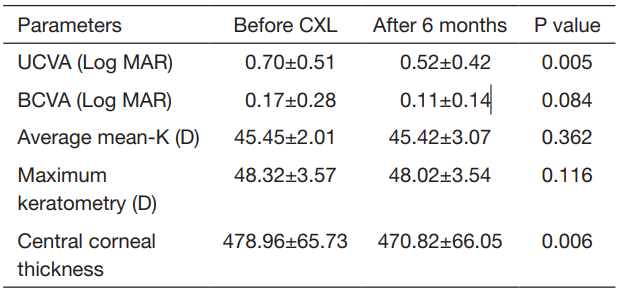1、Wollensak G, Spoerl E, Seiler T. Riboflavin/ultravioleta-inducedcollagen crosslinking for the treatment of keratoconus. Am J Ophthalmol 2003;135:620-7.
2、Kanellopoulos AJ. Long term results of a prospective randomized bilateral eye comparison trial of higher fluence, shorter duration ultraviolet A radiation, and riboflavin collagen cross linking for progressive keratoconus. Clin Ophthalmol 2012;6:97-101.
3、Celik%20HU%2C%20Alag%C3%B6z%20N%2C%20Yildirim%20Y%2C%20et%20al.%20Accelerated%20corneal%20crosslinking%20concurrent%20with%20laser%20in%20situ%20keratomileusis.%20J%20Cataract%20Refract%20Surg%202012%3B38%3A1424-31.
4、Mrochen M. Current status of accelerated corneal crosslinking.Indian J Ophthalmol 2013;61:428-9.
5、Tomas-Barberan S, Fagerholm P. Anterior chamber flare after photorefractive keratectomy. J Refract Surg 1996;12:103-7.
6、El-Harazi SM, Chuang AZ, Yee RW. Assessment of anterior chamber flare and cells after laser in situ keratomileusis. J Cataract Refract Surg 2001;27:693-6.
7、Sen HN, Uusitalo R, Laatikainen L. Subclinical inflammation after laser in situ keratomileusis in corneal grafts. J Cataract Refract Surg 2002;28:782-7.
8、Pisella PJ, Albou-Ganem C, Bourges JL, et al. Evaluation of anterior chamber inflammation after corneal refractive surgery. Cornea 1999;18:302-5.
9、Shah SM, Spalton DJ, Smith SE. Measurement of aqueous cells and flare in normal eyes. Br J Ophthalmol 1991;75:348-52.
10、Szerenyi KD, Campos M, McDonnell PJ. Prostaglandin E2 production after lamellar keratectomy and photorefractive keratectomy. J Refract Corneal Surg 1994;10:413-6.
11、Phillips AF, Szerenyi K, Campos M, et al. Arachidonic acid metabolites after excimer laser corneal surgery. Arch Ophthalmol 1993;111:1273-8.
12、Greenstein SA, Fry KL, Bhatt J, et al. Natural history of corneal haze after collagen crosslinking for keratoconus and corneal ectasia: Scheimpflug and biomicroscopic analysis. J Cataract Refract Surg 2010;36:2105-14.
13、Hashemi H, Seyedian MA, Miraftab M, et al. Corneal collagen cross-linking with riboflavin and ultraviolet a irradiation for keratoconus: long-term results. Ophthalmology 2013;120:1515-20.
14、Vinciguerra R, Romano MR, Camesasca FI, et al. Corneal cross-linking as a treatment for keratoconus: four-year morphologic and clinical outcomes with respect to patient age. Ophthalmology 2013;120:908-16.
15、Hashemi H, Fotouhi A, Miraftab M, et al. Short-term comparison of accelerated and standard methods of corneal collagen crosslinking. J Cataract Refract Surg 2015;41:533-40.
16、Hashemi H, Miraftab M, Seyedian MA, et al. Longterm Results of an Accelerated Corneal Cross-linking Protocol (18 mW/cm2) for the Treatment of Progressive Keratoconus. Am J Ophthalmol 2015;160:1164-1170.e1.
17、Seiler TG, Fischinger I, Koller T, et al. Customized Corneal Cross-linking: One-Year Results. Am J Ophthalmol 2016;166:14-21.




